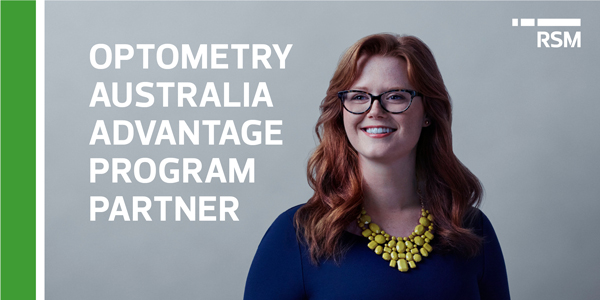1:30min

By RSM
These are unprecedented times for optometry practices across Australia. One thing is certain: the far-reaching economic impact of COVID-19 is having a significant impact on practice cashflow. What options are available to optometrists to help their businesses survive in these difficult times?
Option 1 – Defer ATO payments
Key ATO administrative concessions for businesses impacted by COVID-19 include deferring the payment due date of amounts due for the following up to 12 September 2020:
- Business Activity Statement (including PAYG Instalments)
- Income Tax assessments
- Fringe Benefit Tax Assessments
- Allowing businesses to vary PAYG Instalment amounts to zero for the March 2020 quarter. Also, allowing the varying of the PAYG Instalments amounts for September 2019 and December 2019 quarters to access refunds for these amounts paid if you have overpaid your obligations for the full year.
- Remission of any general interest charges and penalties that have been incurred on or after 23rd Jan 2020
- Assistance with payment arrangement plans with low interest rates
- Allowing businesses on a quarterly cycle to opt in to a monthly GST cycle for quicker access to refund.
Option 2 – Apply for Government support for employers to assist cashflow
The Government is providing up to $100,000 to eligible SMEs, with a minimum payment of $20,000.
- Eligible SME’s include sole traders, partnerships, companies, trusts and not for profit organizations whose aggregate turnover is less than $50 million.
- Eligible entities must have an active ABN as at 12 March 2020.
- Eligible employers will receive a refundable credit of up to $50,000 (minimum of $10,000) for the following activity statement periods: March, April, May and June 2020
- $50,000 is the maximum credit payment in total over this period and will be applied as a credit to the employers’ integrated client account with the Australian Taxation Office (ATO)
- The credit is broadly calculated as 100% of the PAYG withholding tax liability amount for the relevant activity statement period (or 300% of the March 2020 PAYG withholding tax liability for monthly lodgers).
- Additional payment (made July to October 2020) – eligible employers will receive additional payments equal to the total of all of the Cash Boost Payments they have received up to a maximum of $50,000.
Option 3 – Apply for JobKeeper payments to remain engaged with your employees
The JobKeeper subsidy has a start date of 30 March 2020 and will provide cashflow relief to assist employers to retain their employees and financial support to individuals who have been stood down since 1 March 2020. The key elements include:
- The JobKeeper payment of $1,500 per fortnight per eligible employee will be paid to eligible employers for up to six months. This amount will be the gross amount before tax. Employers must ensure that each eligible employee receives at least $1,500 per fortnight (before tax).
- Eligible employers are those whose turnover is reduced relative to a comparable period from 1 March (of at least a month) in a prior year by 30% (if turnover is less than $1b). If you’re newly opened there are special rules for you.
- Businesses must register their interest with the ATO to receive the payment. Registration is currently open.
- Payments will commence early May backdated to 30th March 2020. The ATO will then make payments monthly in arrears
- Full time and part-time employees, certain casual employees including stood down or re-hired employees will be eligible provided they were employed at 1 March 2020
- Eligible employees must be over 16 years in age.
- Businesses without employees such as sole traders, will also be eligible for the JobKeeper payment. They will need to provide their ABN.
- Eligible employers include companies, partnerships, trusts and sole traders.
- Eligible employees include Australian residents, New Zealand Citizens in Australia who hold a subclass 444 special category visa and migrants who are eligible for jobseeker payment or youth allowance (Cth)
- Businesses are not required to pay superannuation guarantee on any additional wages paid because of JobKeeper payments, although they may choose to
- JobKeeper payments will likely constitute taxable wages for the purposes of payroll tax.
Option 4 – Secure extra funding through the Coronavirus SME Guarantee Scheme
Under the Scheme, the Federal government will guarantee 50% of new SME unsecured loans issued by eligible lenders up to the value of $250,000. This effectively represents a guarantee of $125,000.
The Scheme will commence in April 2020 and loans will be made available by participating lenders until 30 September 2020.
The maximum period is up to 3 years and there will be a 6 month initial repayment holiday.
Option 5 – Review your cash flow and negotiate fixed costs
- Talk to your landlord to negotiate rent
- Talk to your bank to negotiate loan repayments
- Review trading budgets and cash flow
- Review all costs and alternative ways to generate income
- Review Employee obligations and payroll tax relief measures in your respective state.
If you need assistance with any of the above, RSM Australia have specialists across the country ready to help. For an initial conversation, please contact:
Murray Calder
Director, Business Advisory
RSM Australia Pty Ltd
E: murray.calder@rsm.com.au
P: 03 9286 8176
Tagged as: Advantage program, COVID-19, Employment